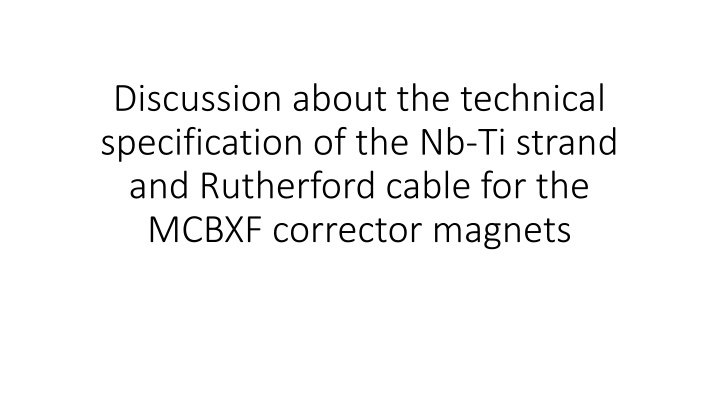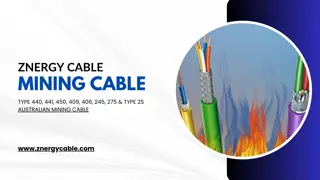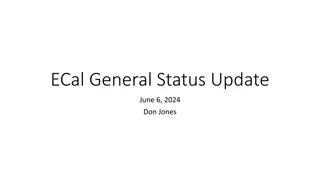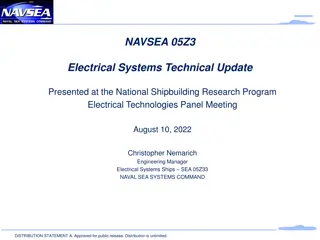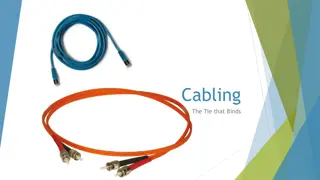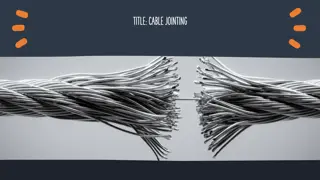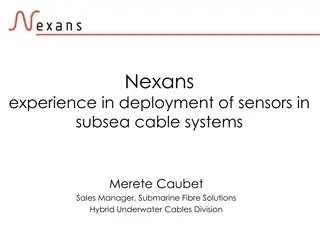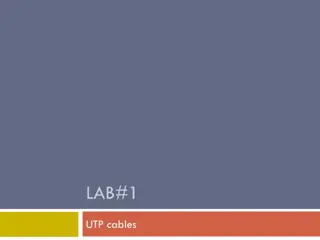Technical Specification of Nb-Ti Strand and Rutherford Cable for MCBXF Corrector Magnets
The technical specs of the Nb-Ti strand and Rutherford cable for MCBXF corrector magnets are discussed, including details on strand characteristics, critical current, n-value, RRR, coating requirements, and more.
Download Presentation

Please find below an Image/Link to download the presentation.
The content on the website is provided AS IS for your information and personal use only. It may not be sold, licensed, or shared on other websites without obtaining consent from the author.If you encounter any issues during the download, it is possible that the publisher has removed the file from their server.
You are allowed to download the files provided on this website for personal or commercial use, subject to the condition that they are used lawfully. All files are the property of their respective owners.
The content on the website is provided AS IS for your information and personal use only. It may not be sold, licensed, or shared on other websites without obtaining consent from the author.
E N D
Presentation Transcript
Discussion about the technical specification of the Nb-Ti strand and Rutherford cable for the MCBXF corrector magnets
Suggested strand specs are based and those of LHC strand 5 in the Tech Spec EDMS No. 102992. C. Scheuerlein, WP 3 meeting, 22.4.2015
Cross section of LHC Nb-Ti strand 5 Nominal strand diameter is 0.48 mm. Nominal filament diameter is 6 m. Nominal copper to superconductor volume ratio is 1.75. Metallographic cross section of 05E00020A09SA C. Scheuerlein, WP 3 meeting, 22.4.2015
Main characteristics of LHC strand 5 (from EDMS No. 102992) C. Scheuerlein, WP 3 meeting, 22.4.2015
Critical current and n-value EDMS No. 102992: The minimum specified critical current as measured by CERN for Strand 5 is 189 A at 1.900 K and 8 T and 194 A at 5 T and 4.222 K . Is 194 A at 4.222 K and 5 T good enough? The variation in critical current of Strand 5 between 5 T, 4.222 K and 8 T, 1.900 K depends on the strand manufacturing process. Therefore the minimum critical current value of 194 A at 4.222 K and 5 T for Strand 5 may have to be increased in order to get the required minimum critical current value of 189A at 1.900 K and 8 T. Since the manufacturer is expected to perform critical current measurements only at 4.222 K, the minimum critical current at 4.222 K and 5 T for Strand 5 will be reviewed and fixed for the Contractor after the manufacturing of strands from the first five billets. CERN has a high interest to increase the critical current of Strand 5. The tenderer will therefore be invited to make an additional quote for a higher critical current. The "n" value must be determined in the range from 10 V/m to 100 V/m at each applied field and must be greater than 40 at 5 T . C. Scheuerlein, WP 3 meeting, 22.4.2015
Residual Resistivity Ratio (RRR) of the Cu stabiliser EDMS No. 102992: must be larger than 150 for annealed strands . Do we need RRR>150 after strand annealing (before cabling)? Will there be a second annealing after cabling? IEEE Xplore Full-Text PDF: - Internet Explorer From Z. Charifoulline IEEE Trans. Appl. Supercond. 16(2), (2006)
Is a strand coating needed for the MCBXF cables? EDMS No. 102992: The individual strands shall be coated with SnAg (5wt % Ag) alloy having a maximum thickness of 1 m and a minimum thickness of 0.1 mm . to obtain an interstrand cross-contact resistance of 40 . Is this tight control of the interstrand resistance needed for the MCBXF cables? Very roughly it is estimated that the cost of the coating is between 10-20% of the strand cost without coating. Higher quality double run coating for 150 km strand is about 60 000 CHF more expensive than single run coating . A cable air HT is needed in order to transform the coating into an oxidised Cu3Sn intermetallic layer that provides the desired electrical resistance and stability. C. Scheuerlein, WP 3 meeting, 22.4.2015
Cable characteristics What are the cable dimension tolerances? Anything else to specify?
Quantities and schedule June 2015: January 2016: 5 UL 400 m (about 2 km cable; about 40 km strand) Today we have about 240 km strand diameter 0.48 mm on stock (Info A. Bonasia) 3 UL 420 m, 3 UL 560 m (about 3 km cable; about 60 km strand) January 2017: 12 UL 700 m, 12 UL 920 m (about 20 km cable; about 400 km strand) October 2017: 70 UL 400 m, 24 UL 560 m (about 29 km cable; about 580 km strand) January 2018: 24 UL 420 m, 24 UL 560 m (about 24 km cable; about 480 km strand) Total: 153 UL with a total length of about 75 km cable Roughly 1500 km strand need to be purchased C. Scheuerlein, WP 3 meeting, 22.4.2015
